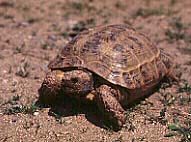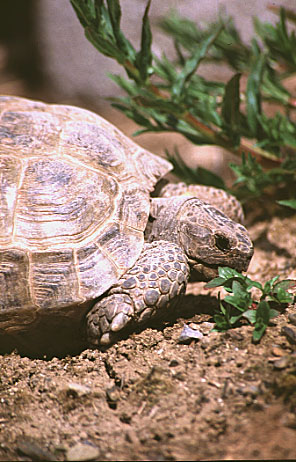
![]() A Habitat for the Horsfield's or Russian Tortoise
A Habitat for the Horsfield's or Russian Tortoise
Andy C. Highfield
Many thousands of Testudo horsfieldii have been collected from the wild and sold via the pet trade in recent years. Regrettably, the majority of these animals will die because of ignorance on the part of their new keepers. Inappropriate housing and diets are most often to blame. No small part of the responsibility for this must lay at the doors of the pet stores who sell these animals, usually with the added bonus (for the store), of additional sales of glass aquariums, heat mats, and various artificial 'reptile substrates'. Unfortunately, most of this equipment only benefits the store, and is actively detrimental to the tortoises themselves. In this brief article, we will look at what Testudo horsfieldii really needs, and why fish tanks are great for fish - not tortoises. The ideal habitat for this species will comprise a very secure outdoor pen, with appropriate substrate and landscaping, and a secondary, covered or indoor area for use in wet and cold weather. This is a species that requires a very dry, well-drained substrate indeed - Horsfield's tortoises are unsuited to maintenance on damp clay soils, or on grass. See our separate article on Outdoor Habitat Design for some good ideas. If Russian tortoises are maintained on damp ground, expect repeated skin, shell and respiratory infections. All is not lost if you do have such a soil type in your garden, however. Simply excavate a large pit to a depth of at least 30 cm (12") and partially fill with gravel. On top of this, fill with a 15 cm (6") layer of fine, sandy soil. This will dramatically improve drainage and will produce a much safer, more arid habitat for your tortoises. The addition of a few 'hills', or mounds, some rocks and some scrubby vegetation will produce a basic outdoor environment that is well suited to this species. The pen should be situated in a bright, sunny location and all perimeters must be very secure indeed - Russian tortoises are highly proficient excavators and possess a remarkable ability to climb near-vertical surfaces. It is preferable if outer perimeter walls are opaque as if tortoises can see through them, they will continually attempt to breach whatever defences are in place. We have found that concrete or cement construction blocks make excellent perimeters for such pens. A height of at least 45 cm (18") is recommended. In areas with a natural predator population (foxes, raccoons) a strong protective wire-mesh cover on a wooden frame should be installed. In addition to this outdoor area, in northern climates at least, some indoor provision will also be required. This can consist of a modestly sized greenhouse laid out internally to resemble the outdoor area, or an area within a polytunnel along the same lines. Certainly, for long-term breeding success, I would recommend that this approach is the one to adopt. Save in the most severe climates, little or no ancillary heating will be necessary if the greenhouse or polytunnel is situated in a sufficiently sunny spot. Even in the UK, temperatures in excess of 30° C (86° F) are regularly attained in these units. Should it be necessary to construct a habitat in the house, an indoor pen or 'tortoise table' type unit is vastly superior to the 'vivarium' accommodation so often recommended by pet stores. It is worth examining the problems caused by fish-tank type vivaria. Tortoises tend to do very badly in confined, poorly ventilated spaces. About the only way to obtain anything like adequate airflow in a typical 'tank' type vivarium is to employ forced-air circulation using fans. Without this, the air rapidly becomes stale and foul. As the tortoise urinates and defecates, humidity within the unit also rises to unacceptable levels (this problem is further exasperated by under-floor heat pads). There are very high occurrences of serious respiratory problems with tortoises kept in this kind of tank. It is very difficult to provide adequate microclimates for tortoises in a relatively small tank. These animals require a substrate depth of at least 10 cm (4") in order to be able to construct a pallet (used at night, to escape from excessive temperatures, and to reduce fluid loses via skin evaporation). A layer of 'reptile bedding' or newspaper is simply inadequate. Where a suitable substrate is not available, anticipate problems with bladder calculi (stones) and kidney problems over the long term. All tortoises require space. If kept in restricted conditions they become bored, out of condition and stressed. Even the largest glass tank is entirely inadequate - and in our opinion, is inhumane. Where indoor accommodation is needed, a large indoor pen (say 2 X 2 meters, or 6' X 6' minimum for one adult tortoise) fitted with several 48" 48 watt full spectrum, high output UV-B tubes or at a height of approximately 30 cm (12") on a wooden, overhead gantry or framework, plus radiant heat for basking, will provide the basis for safe and effective housing for this species. A mixed loam and sand substrate as described previously is also essential. This has proved very successful indeed, and is reasonably easy to keep clean. Scrape the surface weekly, and top up with fresh material. Every few months, change the substrate completely. 'UV-B Heat' lamps are a viable alternative to multiple UV-B fluorescent tubes and separate basking lamps for semi-arid habitat tortoises. See our separate Lighting Guide. Although they do come from a rather dry habitat, clean fresh water should be provided regularly. The diet should consist of leaves, flowers and very little (if any) fruit. This is a species very prone to obesity in captivity; hence, a large pen that encourages activity and exercise is vital. Provided accommodation along the lines suggested above is available, there is no reason why many more keepers should not begin to breed this fascinating species regularly. Getting the message across to the public, and to pet store employees, however, that Russian tortoises and fish tanks are not a good combination is proving difficult, unfortunately. How many tortoises will die unnecessarily before the lesson is finally learned is anyone's guess. 


Ventilation
Lack of microclimates
Lack of exercise
Recommended Reading:
Practical Care of the Russian Tortoise, Testudo horsfieldii (1999) by A. C. Highfield, video with book, Carapace Press (http://www.vidi-herp.com)